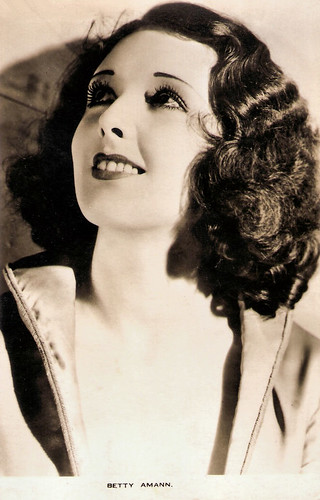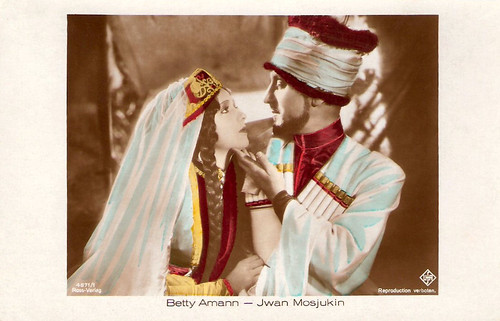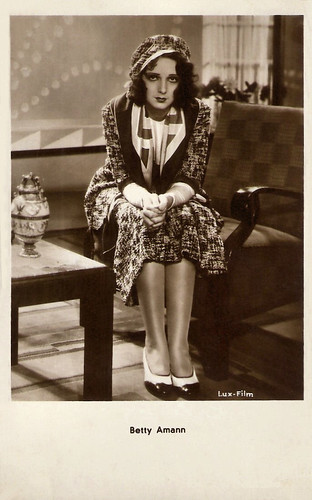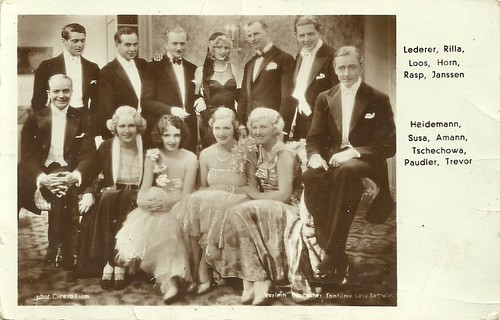Dark-haired German-American actress Betty Amann (1905-1990) started her film career in Hollywood, but director Joe May and producer Erich Pommer discovered her for the German cinema. Her typical role was the immoral and alluring femme fatale who seduces and corrupts men.

German postcard by Ross Verlag, no. 4147/1, 1929-1930. Photo: Ufa.

German postcard by Ross Verlag, no. 7357/1, 1932-1933. Photo: Paramount.

British postcard.
Betty Amann was born Philippine Amann in Pirmasens, Germany, in 1905. Together with her German-American parents, she moved to the United States at an early age.
By her own account, she studied painting at the National Academy School of Fine Arts in New York before she was discovered for the stage and won small parts at the May Palace Theater.
She started her film career with the romantic movie The Kick-off (Wesley Ruggles, 1926). Under the nickname Bee Amann, she starred as a farmer's daughter opposite Tom Tyler in the western Trail of the Horse Thieves (Robert De Lacey, 1929) for the low-budget studio Film Booking Offices of America (FBO).
She returned to Germany and arrived in Berlin in the wake of Louise Brooks. Director Joe May and Ufa-producer Erich Pommer gave her a screentest, and then offered her a leading role in Asphalt (Joe May, 1929). In this masterpiece of the German silent cinema she played a femme fatale thief who corrupts true-blue policeman Gustav Fröhlich. It was Pommer who gave her the pseudonym Betty.
In her next film, Der Sträfling aus Stambul/The Convict From Stambul (Gustav Ucicky, 1929), she was the co-star of Heinrich George and Paul Hörbiger. Soon, more films followed.

German postcard by Ross Verlag, no. 4871/1, 1929-1930 with Ivan Mozzhukhin. Photo: Ufa.

Austrian postcard by Iris Verlag, no. 6016. Photo: Lux-Film.

German postcard. Photo: Cicero Film / Distribution Deutsche Tonfilme. The 'fine fleur' of late silent German cinema stars, united for a photo for an early sound film company. Standing left to right: Francis/Franz Lederer, Walter Rilla, Theodor Loos, Camilla Horn, Fritz Rasp and Walter Janssen, Sitting left to right: Paul Heidemann, Charlotte Susa, Betty Amann, Olga Tschechowa, Maria Paudler and Jack Trevor. Publicity for the early sound comedy Die grosse Sehnsucht/The Great Longing (Stefan Szekely/Steve Sekely, 1930), in which all acted, mostly as themselves - only Loos and Horn played characters. The plot was an excuse for 35 stars to debut in a talking picture.
Betty Amann was the leading lady of the Ufa production Der Weisse Teufel/The White Devil (Alexandre Volkoff, 1929), based on a novel by Leo Tolstoy.
With great style and visual flare Alexandre Volkoff directed this film that represented the European silent tradition at it's finest and most dynamic. Russian émigré Ivan Mozzhukhin, the great star of the French silent cinema aka ‘Mosjoukine’, features as a fiery Caucasian captain Hadscht Murat.
Der Weisse Teufel was his first film to include a synchronised soundtrack: existing of an effective score by Michael Lewin and others, some sequences of singing and whistling, and a range of sound effects, but no dialogue.
The later director Michael Powell was apparently the stills photographer on the film and therefore may be the maker of the photo used for the postcard above.

German postcard by Ross Verlag, no. 5325/2, 1930-1931. Photo: Silva-Film. Publicity still for O alte Burschenherrlichkeit/Oh Those Glorious Old Student Days (Rolf Randolf, 1930) with Werner Fuetterer.

French postcard by Europe, no. 2331. Photo: Bild und Ton GmbH. Publicity still for Hans in allen Gassen/Hans-of-all-trades (Carl Froelich, 1930) with Hans Albers.

Austrian postcard by Iris Verlag, no. 6782. Photo: Verleih Hugo Engel Film. Still for Der Grosse Bluff/The Big Bluff (Georg Jacoby, 1933).
When the sound film arrived Betty Amann kept working in Germany. In the crime film Hans in allen Gassen/Hans in All Alleys (Carl Froelich, 1930), she co-starred with Hans Albers as an alluring stranger who turns out to be a murderess.
From 1931 on she also worked in England. For Alfred Hitchcock she played a trickster in the romantic comedy Rich and Strange (Alfred Hitchcock, 1931). In 1933 she emigrated to Great-Britain.
One of her last roles in a German film was in Schleppzug M 17/Tugboat M 17 (Heinrich George, Werner Hochbaum, 1933) as a prostitute and thief who seduces a family man.
By 1938, she was married to the lawyer David B. Stillman and took up permanent residence in the United States, where she shot the western In Old Mexico (Edward D. Venturini, 1938) with William Boyd. One year later, she could be seen in Nancy Drew… Reporter (William Clemens, 1939), a movie which was part of the Nancy Drew series starring Bonita Granville.
Her last role was one of Gale Sondergaard's harbour prostitutes in the bizarre treasure hunter movie Isle of Forgotten Sins (Edgar G. Ulmer, 1943).
In 1987 Betty Amann was awarded the Filmband in Gold for her attributions to the German cinema. She died in 1990 in Westport, USA.
A scene from Asphalt (1929). Source: Golden Silents (YouTube).
Another scene from Asphalt (1929). Source: Saskia (YouTube).
A scene from Der Weisse Teufel/The White Devil (1929), including a vintage soundtrack made the same year to fit the film with sound. Source: Golden Silents (YouTube).
Sources: Hans J. Wollstein (AllMovie), Thomas Hamilton (IMDb), Filmportal.de, Wikipedia, and IMDb.
German postcard by Ross Verlag, no. 4147/1, 1929-1930. Photo: Ufa.
German postcard by Ross Verlag, no. 7357/1, 1932-1933. Photo: Paramount.

British postcard.
The Kick-off
Betty Amann was born Philippine Amann in Pirmasens, Germany, in 1905. Together with her German-American parents, she moved to the United States at an early age.
By her own account, she studied painting at the National Academy School of Fine Arts in New York before she was discovered for the stage and won small parts at the May Palace Theater.
She started her film career with the romantic movie The Kick-off (Wesley Ruggles, 1926). Under the nickname Bee Amann, she starred as a farmer's daughter opposite Tom Tyler in the western Trail of the Horse Thieves (Robert De Lacey, 1929) for the low-budget studio Film Booking Offices of America (FBO).
She returned to Germany and arrived in Berlin in the wake of Louise Brooks. Director Joe May and Ufa-producer Erich Pommer gave her a screentest, and then offered her a leading role in Asphalt (Joe May, 1929). In this masterpiece of the German silent cinema she played a femme fatale thief who corrupts true-blue policeman Gustav Fröhlich. It was Pommer who gave her the pseudonym Betty.
In her next film, Der Sträfling aus Stambul/The Convict From Stambul (Gustav Ucicky, 1929), she was the co-star of Heinrich George and Paul Hörbiger. Soon, more films followed.

German postcard by Ross Verlag, no. 4871/1, 1929-1930 with Ivan Mozzhukhin. Photo: Ufa.

Austrian postcard by Iris Verlag, no. 6016. Photo: Lux-Film.

German postcard. Photo: Cicero Film / Distribution Deutsche Tonfilme. The 'fine fleur' of late silent German cinema stars, united for a photo for an early sound film company. Standing left to right: Francis/Franz Lederer, Walter Rilla, Theodor Loos, Camilla Horn, Fritz Rasp and Walter Janssen, Sitting left to right: Paul Heidemann, Charlotte Susa, Betty Amann, Olga Tschechowa, Maria Paudler and Jack Trevor. Publicity for the early sound comedy Die grosse Sehnsucht/The Great Longing (Stefan Szekely/Steve Sekely, 1930), in which all acted, mostly as themselves - only Loos and Horn played characters. The plot was an excuse for 35 stars to debut in a talking picture.
Mosjoukine
Betty Amann was the leading lady of the Ufa production Der Weisse Teufel/The White Devil (Alexandre Volkoff, 1929), based on a novel by Leo Tolstoy.
With great style and visual flare Alexandre Volkoff directed this film that represented the European silent tradition at it's finest and most dynamic. Russian émigré Ivan Mozzhukhin, the great star of the French silent cinema aka ‘Mosjoukine’, features as a fiery Caucasian captain Hadscht Murat.
Der Weisse Teufel was his first film to include a synchronised soundtrack: existing of an effective score by Michael Lewin and others, some sequences of singing and whistling, and a range of sound effects, but no dialogue.
The later director Michael Powell was apparently the stills photographer on the film and therefore may be the maker of the photo used for the postcard above.
German postcard by Ross Verlag, no. 5325/2, 1930-1931. Photo: Silva-Film. Publicity still for O alte Burschenherrlichkeit/Oh Those Glorious Old Student Days (Rolf Randolf, 1930) with Werner Fuetterer.

French postcard by Europe, no. 2331. Photo: Bild und Ton GmbH. Publicity still for Hans in allen Gassen/Hans-of-all-trades (Carl Froelich, 1930) with Hans Albers.
Austrian postcard by Iris Verlag, no. 6782. Photo: Verleih Hugo Engel Film. Still for Der Grosse Bluff/The Big Bluff (Georg Jacoby, 1933).
Rich and Strange
When the sound film arrived Betty Amann kept working in Germany. In the crime film Hans in allen Gassen/Hans in All Alleys (Carl Froelich, 1930), she co-starred with Hans Albers as an alluring stranger who turns out to be a murderess.
From 1931 on she also worked in England. For Alfred Hitchcock she played a trickster in the romantic comedy Rich and Strange (Alfred Hitchcock, 1931). In 1933 she emigrated to Great-Britain.
One of her last roles in a German film was in Schleppzug M 17/Tugboat M 17 (Heinrich George, Werner Hochbaum, 1933) as a prostitute and thief who seduces a family man.
By 1938, she was married to the lawyer David B. Stillman and took up permanent residence in the United States, where she shot the western In Old Mexico (Edward D. Venturini, 1938) with William Boyd. One year later, she could be seen in Nancy Drew… Reporter (William Clemens, 1939), a movie which was part of the Nancy Drew series starring Bonita Granville.
Her last role was one of Gale Sondergaard's harbour prostitutes in the bizarre treasure hunter movie Isle of Forgotten Sins (Edgar G. Ulmer, 1943).
In 1987 Betty Amann was awarded the Filmband in Gold for her attributions to the German cinema. She died in 1990 in Westport, USA.
A scene from Asphalt (1929). Source: Golden Silents (YouTube).
Another scene from Asphalt (1929). Source: Saskia (YouTube).
A scene from Der Weisse Teufel/The White Devil (1929), including a vintage soundtrack made the same year to fit the film with sound. Source: Golden Silents (YouTube).
Sources: Hans J. Wollstein (AllMovie), Thomas Hamilton (IMDb), Filmportal.de, Wikipedia, and IMDb.
No comments:
Post a Comment